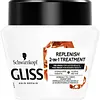What's inside
What's inside
 Key Ingredients
Key Ingredients

No key ingredients
 Benefits
Benefits

 Concerns
Concerns

 Ingredients Side-by-side
Ingredients Side-by-side

Water
Skin ConditioningCetearyl Alcohol
EmollientGlycerin
HumectantIsopropyl Myristate
EmollientStearamidopropyl Dimethylamine
EmulsifyingGlycine Soja Oil
EmollientCoco-Caprylate/Caprate
EmollientSodium Hydroxide
BufferingHydroxypropyl Guar Hydroxypropyltrimonium Chloride
Arginine
MaskingHelianthus Annuus Seed Oil
EmollientSalicylic Acid
MaskingLimonene
PerfumingBenzyl Alcohol
PerfumingPanthenol
Skin ConditioningWater
Skin ConditioningCetearyl Alcohol
EmollientIsopropyl Myristate
EmollientBehentrimonium Chloride
PreservativeDistearoylethyl Hydroxyethylmonium Methosulfate
Hydrolyzed Keratin
HumectantCombretum Farinosum Flower Nectar
MaskingPrunus Armeniaca Kernel Oil
MaskingAmodimethicone/Morpholinomethyl Silsesquioxane Copolymer
Guar Hydroxypropyltrimonium Chloride
Skin ConditioningIsopropyl Alcohol
SolventCetyl Palmitate
EmollientParfum
MaskingStearamidopropyl Dimethylamine
EmulsifyingGlycerin
HumectantCitric Acid
BufferingPotassium Sorbate
PreservativeCetrimonium Chloride
AntimicrobialDimethicone
EmollientPhenoxyethanol
PreservativeBenzyl Alcohol
PerfumingTrideceth-5
EmulsifyingMethylparaben
PreservativeLinalool
PerfumingWater, Cetearyl Alcohol, Isopropyl Myristate, Behentrimonium Chloride, Distearoylethyl Hydroxyethylmonium Methosulfate, Hydrolyzed Keratin, Combretum Farinosum Flower Nectar, Prunus Armeniaca Kernel Oil, Amodimethicone/Morpholinomethyl Silsesquioxane Copolymer, Guar Hydroxypropyltrimonium Chloride, Isopropyl Alcohol, Cetyl Palmitate, Parfum, Stearamidopropyl Dimethylamine, Glycerin, Citric Acid, Potassium Sorbate, Cetrimonium Chloride, Dimethicone, Phenoxyethanol, Benzyl Alcohol, Trideceth-5, Methylparaben, Linalool
Ingredients Explained
These ingredients are found in both products.
Ingredients higher up in an ingredient list are typically present in a larger amount.
Benzyl Alcohol is most commonly used as a preservative. It also has a subtle, sweet smell. Small amounts of Benzyl Alcohol is not irritating and safe to use in skincare products. Most Benzyl Alcohol is derived from fruits such as apricots.
Benzyl Alcohol has both antibacterial and antioxidant properties. These properties help lengthen the shelf life of products. Benzyl Alcohol is a solvent and helps dissolve other ingredients. It can also improve the texture and spreadability.
Alcohol comes in many different forms. Different types of alcohol will have different effects on skin. This ingredient is an astringent alcohol.
Using high concentrations of these alcohols are drying on the skin. They may strip away your skin's natural oils and even damage your skin barrier. Astringent alcohols may also irritate skin.
Other types of astringent alcohols include:
According to the National Rosacea Society based in the US, you should be mindful of products with these alcohols in the top half of ingredients.
Any type of sanitizing product will have high amounts of alcohol to help kill bacteria and viruses.
Learn more about Benzyl AlcoholCetearyl alcohol is a mixture of two fatty alcohols: cetyl alcohol and stearyl alcohol. It is mainly used as an emulsifier. Emulsifiers help prevent the separation of oils and products. Due to its composition, it can also be used to thicken a product or help create foam.
Cetearyl alcohol is an emollient. Emollients help soothe and hydrate the skin by trapping moisture.
Studies show Cetearyl alcohol is non-toxic and non-irritating. The FDA allows products labeled "alcohol-free" to have fatty alcohols.
This ingredient is usually derived from plant oils such as palm, vegetable, or coconut oils. There is debate on whether this ingredient will cause acne.
Due to the fatty acid base, this ingredient may not be Malassezia folliculitis safe.
Learn more about Cetearyl AlcoholGlycerin is already naturally found in your skin. It helps moisturize and protect your skin.
A study from 2016 found glycerin to be more effective as a humectant than AHAs and hyaluronic acid.
As a humectant, it helps the skin stay hydrated by pulling moisture to your skin. The low molecular weight of glycerin allows it to pull moisture into the deeper layers of your skin.
Hydrated skin improves your skin barrier; Your skin barrier helps protect against irritants and bacteria.
Glycerin has also been found to have antimicrobial and antiviral properties. Due to these properties, glycerin is often used in wound and burn treatments.
In cosmetics, glycerin is usually derived from plants such as soybean or palm. However, it can also be sourced from animals, such as tallow or animal fat.
This ingredient is organic, colorless, odorless, and non-toxic.
Glycerin is the name for this ingredient in American English. British English uses Glycerol/Glycerine.
Learn more about GlycerinIsopropyl Myristate is an emollient, thickening agent, and texture enhancer. It is created from isopropyl alcohol and myristic acid.
It is used to help other ingredients be better absorbed. It is also an emollient and may help soften and hydrate the skin.
The comedogenic rating of this ingredient depends on the concentration. Lower amounts results in a lower rating.
Isopropyl Myristate may not be fungal acne safe. It can potentially worsen acne prone skin.
Learn more about Isopropyl MyristateWe don't have a description for Stearamidopropyl Dimethylamine yet.
Water. It's the most common cosmetic ingredient of all. You'll usually see it at the top of ingredient lists, meaning that it makes up the largest part of the product.
So why is it so popular? Water most often acts as a solvent - this means that it helps dissolve other ingredients into the formulation.
You'll also recognize water as that liquid we all need to stay alive. If you see this, drink a glass of water. Stay hydrated!
Learn more about Water